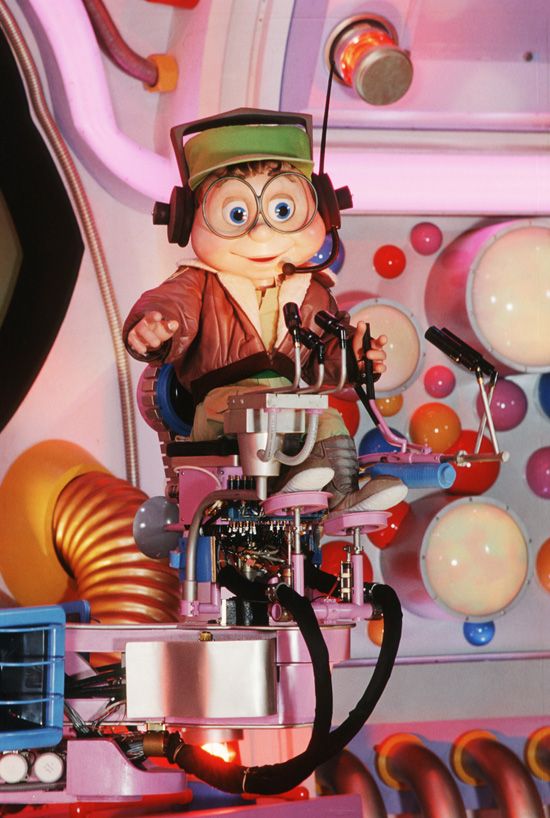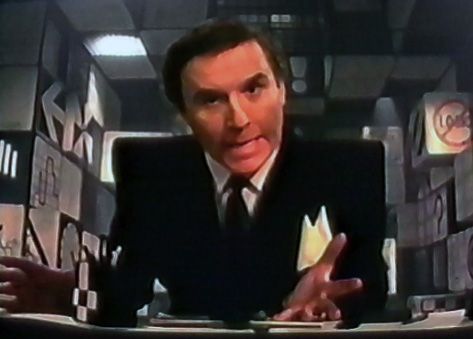Cranium Command, a charming multi-faceted presentation outlining how the brain interacts with different parts of the human body, debuted with and inside EPCOT’s Wonders of Life Pavilion in October of 1989. The popular show was unique in the way it combined multiple mediums seemingly effortlessly. The path to its creation, however, was anything but effortless.
 |
| Cranium Command entrance photo courtesy of jerryrees.com |
While enjoying the party for Disney-MGM Studios’ Opening Day, Jerry Rees was motioned over by a small group of gentlemen: Michael Eisner, Jeffrey Katzenberg, and George Lucas. They were talking about the Indiana Jones Stunt Spectacular, which Lucas had deemed not ready for Opening Day. He told Jerry it needed storytelling and showmanship, and asked him to fix it. Eisner and Katzenberg agreed. Jerry, who was celebrating four of his shows that were debuting that day, accepted the assignment.
“Later that same night,” Jerry recalled, “I was approached by Peter Schneider. He told me that the team had decided to put me on another ‘go fix it’ mission as well. It was a project called ‘Cranium Command’.” The project, already halfway through production at Colossal Pictures, was unanimously loathed by everyone at Disney. Jerry was tasked with reviewing the project, assessing its weaknesses, and fixing them.
After review, Jerry partook in a conference call with Disney brass, which included: Eisner, Katzenberg, Marty Sklar, Tom Fitzgerald, and others. Jerry came prepared. He provided detailed notes indicating the show’s faults as he saw them, and several suggestions to make the show viable.
A few of the things wrong were:
• The educational issues were so obvious and patronizing that a 5-year-old would find it embarrassingly awful to sit through.
• There was no sense of living inside a real person's mind - someone you cared about.
• The eye screens were only used occasionally to "teach" you a lesson, then turned off, leaving an important feature of the theater blank.
• The animated body parts were cliche.
His suggestions included:
• Rewrite it from the ground up to tell an involving story and hide the teaching in the entertainment.
• Direct all performances, including Buzzy and the body parts to be believable, warm and relatable.
• Keep the eyes open!!! After all, that's how we live life! If we get in trouble, we can't turn our eyes off until we figure things out.
• Turn people's expectations on their heads and make the body parts - like Right Brain, Adrenaline, etc. live action actors in crazy sets.
The previous production company was relieved of its duties, and Jerry and his team were assigned to the project. The upside was, he was granted tons of creative freedom. The downside was, half of the schedule was already gone, and shifting the attraction’s opening date was not an option.
Jerry and his team worked around the clock on both “fix-it” projects. Their workspace for storyboarding Cranium Command was in the "fishbowl" of the Animation Tour. “Our just-completed Back To Neverland film, starring Robin Williams and Walter Cronkite, was playing in the theater,” Jerry remembers. “As guests walked out of the theater, the first thing they saw when they looked through the glass was Kirk [Wise], Gary [Trousdale], Rebecca [Rees] and Darrell [Rooney] storyboarding Cranium Command. The guests had no idea that they were looking at the birth of an EPCOT attraction of course. But the boards were there for everyone to see.”
The plan for Cranium Command was to utilize several different elements to tell its story. Jerry directed the entire main show. “Everything that you see and hear from the 8 screens, 2 Audio-Animatronic figures, and the 10 discreet channels of sound,” he said. The pre-show, a five-minute animated short, was directed by Gary Trousdale and Kirk Wise (who would both go on to co-direct Beauty and the Beast). Animator Steve Moore worked on the animation in the Cranium Command pre-show, and also worked with Jerry on Michael and Mickey, Back to Neverland, and Alien Encounter.
The show featured young captain “Buzzy” (one of the two Audio-Animatronic figures) being given his first assignment: piloting the brain of a 12-year-old boy. The officer-in-charge, General Knowledge, referred to the boy’s brain as “the most unstable craft in the fleet.” Being inside the mind of a boy meant lots of POV (point of view) shots, as the audience was seeing what he was seeing. “The complexity of directing continuous POV footage with no apparent cuts—plus the adjoining screens and figures who had to interact with the ongoing POV was wild,” Jerry mused.
 |
| "Buzzy", our Audio-Animatronic captain photo courtesy of disneyparksblog.com |
Since several of the sets were actually in different locations, Jerry had to think of clever ways to use cuts. For example, when the boy leaves the principal’s office, he turns to the right and the audience sees his school hallway, complete with lockers. The problem was, there was no hallway outside of the principal’s office. Turning right led straight into a wall. So they set up items like a chair, a plant, and a picture just outside of the office. They filmed the scene, turned right, and cut. They then packed up, moved across town to the school with the hallway, re-set up the same chair, plant, and picture, and filmed the rest of the scene. “In the editing room we picked a matching blur frame of the tableau to cut on,” Jerry said. “It worked really well. No special effects, no optical help. There was no such thing as digital help back then; but lots of planning and coordination.”
A stickler for detail, Jerry took the director of photography and camera operator to each location prior to shooting, and filmed tests using his personal video camera. He wanted to figure out how to make the camera express "behavior", so that the audience would feel like they were inside the mind of a person with emotions.
Once all of the POV shots were complete, Jerry then had to begin filming the body part sequences. In order for it to all match up, he had the POV footage playing back at the same time. It was quite the tightrope walk for Jerry; directing each “body part,” with one eye on the POV footage so he could provide the actors with their cues.
 |
| Charles Grodin played the Left Brain, always pushing for the practical solution photo courtesy of jerryrees.com |
After the complicated filming had wrapped, Jerry then began the complicated post-production process. Even though he mocked up as much of the Cranium Command theater as he could in Los Angeles, it was hard for people to understand how the final theater was going to work. While reviewing the footage, Katzenberg would lean over to him and ask, “Who's talking?" Jerry explained that it was "Buzzy", an Audio-Animatronic figure that would be in the theater with the guests. Several folks just shook their heads during post and said to Jerry, "Well, I'm glad you know how it all comes together."
The other Audio-Animatronic character, the Hypothalamus, was articulated by Rebecca Rees (Jerry on Rebecca: “She came through Art Center to Disney - I came through Cal Arts to Disney - and yes, we're still married!”). She came up with the whole droning character that is taken for granted because all he does is automatic functions. Everyone loved it, and pre-show co-director Kirk Wise came up with the perfect voice.
When I asked Jerry what the most challenging aspect was for him while working on Cranium Command, his response was, “Keeping all of the various participants on track when none of them understood exactly how they fit into the wild tapestry of the show.” He then shared a fun story: “I got called away from the set to sit with some executives who oversaw budget. They said, ‘Jerry, this is too ambitious. You can't stage an entire POV food fight!’
‘Are you going to give me more resources?’ I asked.
‘No,’ they replied.
‘Are you cool with me delivering part of a show instead of a whole show?’ I asked.
‘No,’ they replied.
‘Then I guess I should get back to the set,’ I said.”
 |
| One of the many POV shots, the audience meets the boy's crush photo courtesy of jerryrees.com |
Jerry shot the scene as originally planned and on-schedule. The naysayers were relieved. The scene, as well as the rest of the show, turned out wonderfully. Cranium Command quickly became a guest favorite thanks to its charm, ingenuity, and educational aspects. Astrophysicist/astronomer/author Carl Sagan had this to say about the show: “Seated in the theater, you find yourself inside the head of an eleven-year-old boy. You look out through his eyes. You encounter his typical daily crises; bullies, authoritarian adults, crushes on girls. You hear the voice inside his head. You witness his neurological and hormonal responses to his social environment. And you get to wonder how you work on the inside…”
The Wonders of Life Pavilion began operating seasonally in 2004, and closed for good on New Year’s Day, 2007. There hasn’t been a show quite like Cranium Command since then, but luckily for us, Disney continues to utilize Jerry’s talents to this day.
Love that you just posted this! I was just trying to explain Cranium Command to my husband (who never saw it) the other day, totally going to have to show him these pics!
ReplyDeleteThank you! Jerry gave me so much amazing information. :)
DeleteHuzzah! That's a great look at the creation of a truly charming attraction. Thanks so much.
ReplyDeleteThanks Chris! I'm glad you enjoyed it.
DeleteAs I myself have been interested in the historical aspects in the Wonders of Life pavilion, especially with the "backstage aspects" pertaining to its iconic attractions – yes I wrote an article pertaining to character development from Captain Cortex to Captain Buzzy – I commend you for covering this aspect of the attraction development. I'm also on the lookout for other stories on this development trail, but I might be treading on sensitive ground here. Anyways, since I run a blog and an informational site – WOL4EVA as simply labelled – feel free to look them up and provide some thoughts on that too! So far, excellent article, will link this one to my blog for others to have a read!
ReplyDelete